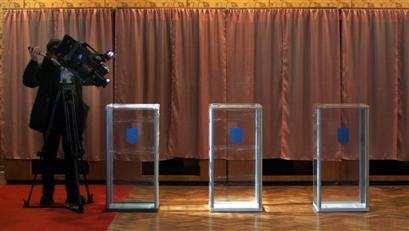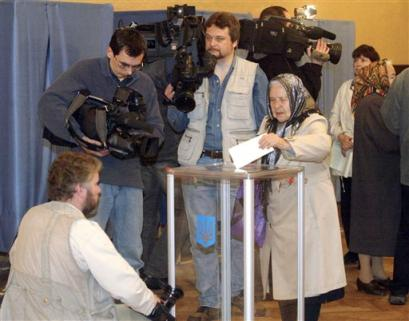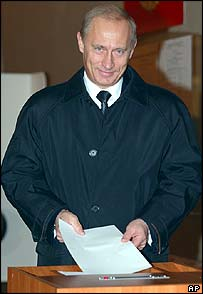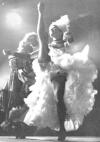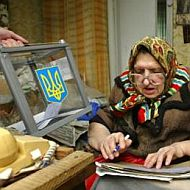HOME
DISINFORMATION
PEOPLE
KUCHMA
PUTIN
YUSHCHENKO
Viktor Yushchenko: Compromised confidentiality in Ukrainian voting
Letter 02
27-Dec-2004
"Casting ballots into transparent boxes may significantly undermine the guarantee of confidentiality." � Lubomyr Prytulak
NOTE ADDED 08-Jan-2004.
One may assume that in the upper of this pair of photographs, the camera is being set up not to capture images of empty ballot boxes, but to get close-ups of voters inserting their ballots into them after the polls open.
The lower photograph especially illustrates the close inspection of a ballot that is possible as it is being cast, and after it has fallen into the box.
NOTE ADDED 13-Jan-2004.
Russian ballot boxes appear to be opaque, which is as it should be.
27 December 2004
Viktor Yushchenko, President Elect
Vul. Prorizna, 9, Office 20
01034 Kyiv-34
Ukraine
Mr President Elect:
One of the mysteries of the presidential election of 26-Dec-2004 is how Viktor Yanukovych could have received as much as 44% of the vote when he has been so thoroughly discredited. Part of the answer might lie in his continuing reliance on bribery and intimidation which continue to be rendered feasible by a failure to achieve adequate voting confidentiality.
The inadequate voting confidentiality originates from the ballot box being transparent, and can be appreciated in the Channel 5 cancan video, originally at www.5tv.com.ua/video/143/45/.
That is, it can be seen to be possible for the ballot to fall with its face upward so that the voter's choice becomes visible, and where it can be inspected by successive voters, or by spectators, or by election officials. If the ballot is folded, then there is some possibility that it will open as it flies through the air within the ballot box, which can be seen to be tall. And even if a folded ballot falls without opening, there is some possibility that a voter's heavy mark can be read through the paper � either through the rear of the paper on which the voter's mark was placed, or through the paper that covers the voter's mark. Perhaps the pages of a folded ballot can separate slightly, permitting the inside to be viewed from a certain angle, especially if the ballot falls into a standing position rather than flat. In the video, sometimes the ballot can be seen to curl, with possible effects on the visibility of what is written on it. And finally, even if the voter's mark cannot be seen directly or through paper, there remains the possibility that the ballot will fall against one of the walls of the ballot box, and so will be identifiable as belonging to the voter for some time, and possibly even after all ballots have been cast.
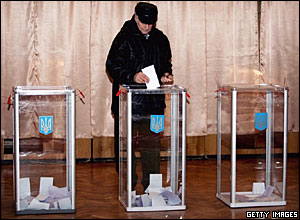
Ballots have a distance to fall, and may end up in positions which render them identifiable even as the box continues to fill.
|
|
To elaborate the last point above somewhat, if I were to see you casting your ballot, I would be able to observe it landing on the other ballots inside the box. As still more ballots were subsequently thrown on top of your ballot, I would for some time continue to know which one was yours. If, furthermore, your ballot happened to fall, or slide, against the side of the box, I might be able to continue identifying it even at the end of the day when it had been covered with hundreds, or with thousands, of other ballots.
Now a voter who is about to mark his ballot has no way of foreseeing its fate after he throws it into the box. Maybe it will land face upward and expose his vote to anybody who cares to look. If the ballot is folded, maybe it will open up as it flies through the air. Or, maybe the voter's mark will be readable through the back of the paper, or through the front of the covering paper. Maybe his ballot will fall, or slide, against the side of the box where it will remain identifiable as his. It must even sometimes happen that the ballot lands with the surface containing the voter's writing pressed flat against the side of the box, where it may remain plainly readable even to the end of the day. Any one or more of these things might happen, and the voter cannot be certain as he is about to mark his choice that none will happen and that he can depend on absolute confidentiality. Merely the anticipation that his ballot will remain visible and noticeable at the top of the heap or against the wall as he walks away from the ballot box may make him uncomfortable, and the anticipation of that discomfort may influence his vote. Although at the beginning of the day the ballots already in the box may be so far below eye level that voters in a standing position would have difficulty seeing much of value on them, as the day progressed the pile of ballots might approach waist level, making the uppermost of them more readable. But dissatisfaction with transparent ballot boxes should not require proof that they frequently or easily yield information on how people voted � rather, it should be sufficient to point out that transparent ballot boxes might sometimes yield privileged information, and that voters' awareness of this mere possibility could have a chilling effect out of all proportion to the small or negligible amount of information actually disclosed in the typical case.
There arises the further question of whether the physical layout of the ballot boxes is always as shown above, or whether it might sometimes approximate that shown in the photograph to the right published by Ukrainska Pravda at
www2.pravda.com.ua/archive/2004/december/26/1.shtml
, and whose significance is unclear. If it shows a small ballot box in use very close to the eyes of an election official, then the threat of information leakage looms large, along with an acute awareness of loss of confidentiality on the part of the voter.
Therefore, the transparent ballot box must be recognized as potentially depriving the voter of his guarantee of confidentiality, and of biasing his vote. If he may lose his job or be beaten for choosing a certain candidate, then undependable confidentiality may affect him as he is about to mark his ballot. If he has been paid to vote for a certain candidate, then he may rightly fear that his compliance will be verified. If one voter out of five distrusts the confidentiality of his vote, then 5.8 million voters distrust confidentiality and are vulnerable to pressure to vote against their conscience. It may be possible that almost all voters sensed that the transparent ballot box compromised their confidentiality.
As a fourth round of voting is unthinkable, there is no remedy for past elections. In future elections, opaque ballot boxes must be used.
Lubomyr Prytulak
HOME
DISINFORMATION
PEOPLE
KUCHMA
PUTIN
YUSHCHENKO


